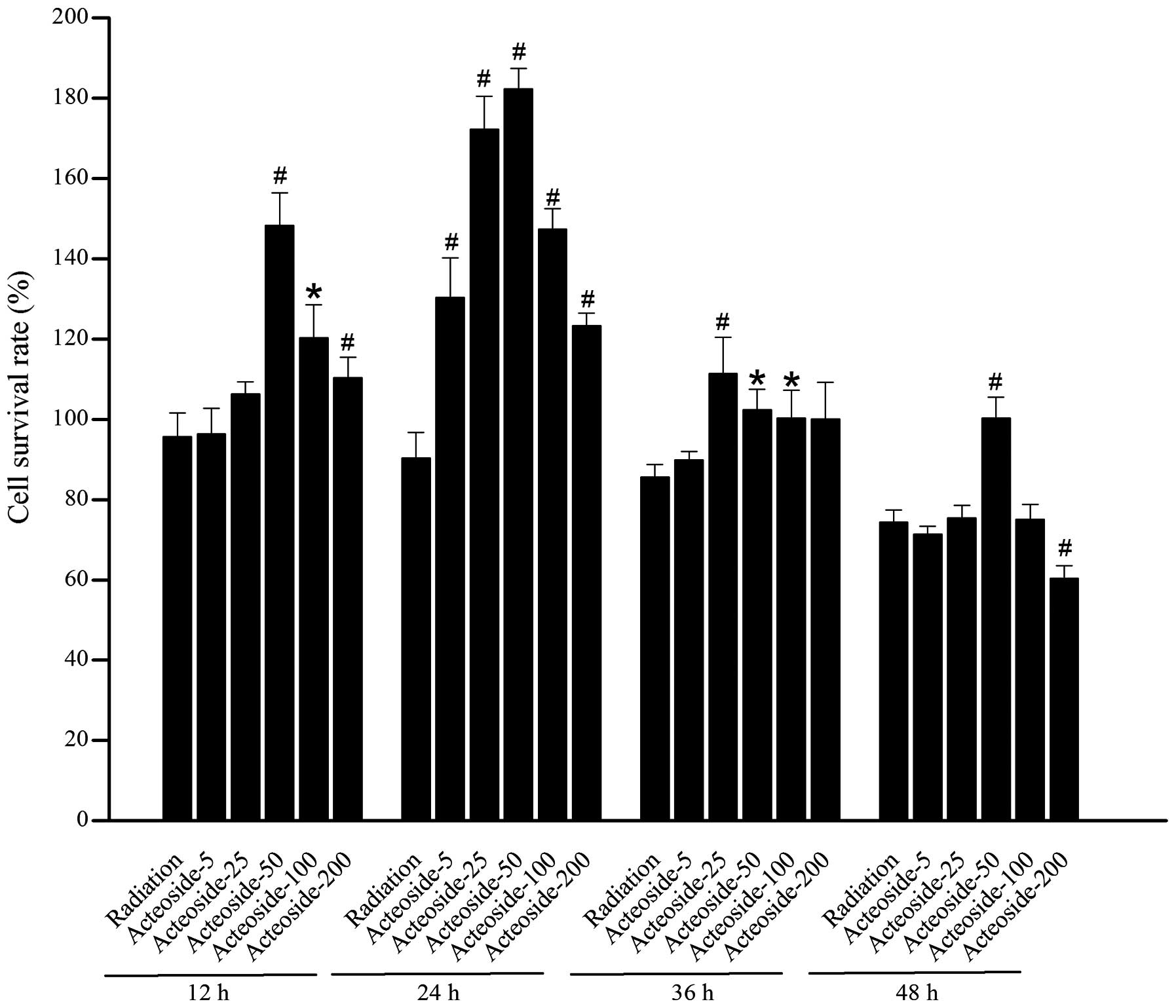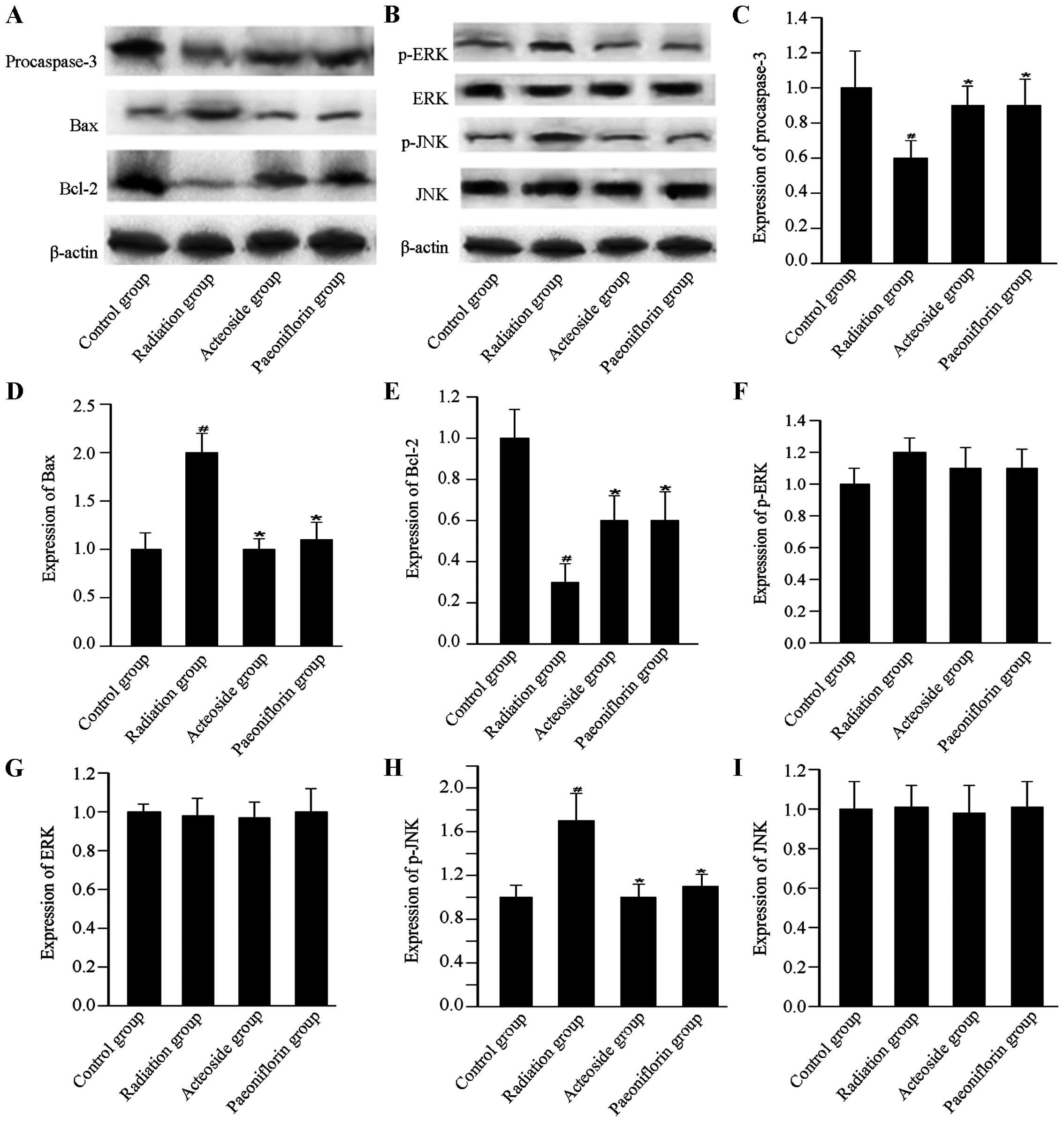|
1
|
Mothersill C and Seymour C:
Radiation-induced bystander effects: are they good, bad or both?
Med Confl Surviv. 21:101–110. 2005. View Article : Google Scholar : PubMed/NCBI
|
|
2
|
Jiang Y and Tu PF: Analysis of chemical
constituents in Cistanche species. J Chromatogr A. 1216:1970–1979.
2009. View Article : Google Scholar
|
|
3
|
Xuan GD and Liu CQ: Research on the effect
of phenylethanoid glycosides (PEG) of the Cistanche deserticola on
anti-aging in aged mice induced by D-galactose. Zhong Yao Cai.
31:1385–1388. 2008.In Chinese.
|
|
4
|
Geng X, Song L, Pu X and Tu P:
Neuroprotective effects of phenylethanoid glycosides from
Cistanches salsa against
1-methyl-4-phenyl-1,2,3,6-tetrahydropyridine (MPTP)-induced
dopaminergic toxicity in C57 mice. Biol Pharm Bull. 27:797–801.
2004. View Article : Google Scholar : PubMed/NCBI
|
|
5
|
Koo KA, Kim SH, Oh TH and Kim YC:
Acteoside and its aglycones protect primary cultures of rat
cortical cells from glutamate-induced excitotoxicity. Life Sci.
79:709–716. 2006. View Article : Google Scholar : PubMed/NCBI
|
|
6
|
He ZD, Lau KM, Xu HX, Li PC, Pui-Hay and
But P: Antioxidant activity of phenylethanoid glycosides from
Brandisia hancei. J Ethnopharmacol. 71:483–486. 2000. View Article : Google Scholar : PubMed/NCBI
|
|
7
|
Diaz AM, Abad MJ, Fernández L, Silván AM,
De Santos J and Bermejo P: Phenylpropanoid glycosides from
Scrophularia scorodonia: in vitro anti-inflammatory activity. Life
Sci. 74:2515–2526. 2004. View Article : Google Scholar : PubMed/NCBI
|
|
8
|
Lei L, Yang F, Zhang T, Tu P, Wu L and Ito
Y: Preparative isolation and purification of acteoside and
2′-acetyl acteoside from Cistanches salsa (C.A. Mey) G Beck by
high-speed counter-current chromatography. J Chromatogr A.
912:181–185. 2001. View Article : Google Scholar : PubMed/NCBI
|
|
9
|
Li Y, Gan L, Li GQ, Deng L, Zhang X and
Deng Y: Pharmacokinetics of plantamajoside and acetoside from
Plantago asiatica in rats by liquid chromatography-mass
spectrometry. J Pharm Biomed Anal. 89:251–256. 2014. View Article : Google Scholar
|
|
10
|
Demidenko ZN, Vivo C, Halicka HD, et al:
Pharmacological induction of Hsp70 protects apoptosis-prone cells
from doxorubicin: comparison with caspase-inhibitor- and
cycle-arrest-mediated cytoprotection. Cell Death Differ.
13:1434–1441. 2006. View Article : Google Scholar
|
|
11
|
Chiu SJ, Lee MY, Chen HW, Chou WG and Lin
LY: Germanium oxide inhibits the transition from G2 to M phase of
CHO cells. Chem Biol Interact. 141:211–228. 2002. View Article : Google Scholar : PubMed/NCBI
|
|
12
|
Cathcart R, Schwiers E and Ames BN:
Detection of picomole levels of hydroperoxides using a fluorescent
dichlorofluorescein assay. Anal Biochem. 134:111–116. 1983.
View Article : Google Scholar : PubMed/NCBI
|
|
13
|
Kurien BT and Scofield RH: Western
blotting. Methods. 38:283–293. 2006. View Article : Google Scholar : PubMed/NCBI
|
|
14
|
Chinese Pharmacopoeial Commission:
Pharmacopoeia of the People’s Republic of China. 1. People’s
Medical Publishing House; Beijing, China: pp. 1262010
|
|
15
|
Hu S, Sun W, Wei W, et al: Involvement of
the prostaglandin E receptor EP2 in paeoniflorin-induced human
hepatoma cell apoptosis. Anticancer Drugs. 24:140–149. 2013.
View Article : Google Scholar
|
|
16
|
Tsuboi H, Hossain K, Akhand AA, et al:
Paeoniflorin induces apoptosis of lymphocytes through a
redox-linked mechanism. J Cell Biochem. 93:162–172. 2004.
View Article : Google Scholar : PubMed/NCBI
|
|
17
|
Valko M, Rhodes CJ, Moncol J, Izakovic M
and Mazur M: Free radicals, metals and antioxidants in oxidative
stress-induced cancer. Chem Biol Interact. 160:1–40. 2006.
View Article : Google Scholar : PubMed/NCBI
|
|
18
|
An Z, Qi Y, Huang D, et al: EGCG inhibits
Cd(2+)-induced apoptosis through scavenging ROS rather than
chelating Cd(2+) in HL-7702 cells. Toxicol Mech Methods.
24:259–267. 2014. View Article : Google Scholar : PubMed/NCBI
|
|
19
|
Yang HL, Chen CS, Chang WH, et al: Growth
inhibition and induction of apoptosis in MCF-7 breast cancer cells
by Antrodia camphorata. Cancer Lett. 231:215–227. 2006. View Article : Google Scholar : PubMed/NCBI
|
|
20
|
Kluck RM, Bossy-Wetzel E, Green DR and
Newmeyer DD: The release of cytochrome c from mitochondria: a
primary site for Bcl-2 regulation of apoptosis. Science.
275:1132–1136. 1997. View Article : Google Scholar : PubMed/NCBI
|
|
21
|
Ryan KM, Phillips AC and Vousden KH:
Regulation and function of the p53 tumor suppressor protein. Curr
Opin Cell Biol. 13:332–337. 2001. View Article : Google Scholar : PubMed/NCBI
|
|
22
|
Junttila MR, Li SP and Westermarck J:
Phosphatase-mediated crosstalk between MAPK signaling pathways in
the regulation of cell survival. FASEB J. 22:954–965. 2008.
View Article : Google Scholar
|
|
23
|
Pu X, Song Z, Li Y, Tu P and Li H:
Acteoside from Cistanche salsa inhibits apoptosis by
1-methyl-4-phenylpyridinium ion in cerebellar granule neurons.
Planta Med. 69:65–66. 2003. View Article : Google Scholar : PubMed/NCBI
|















